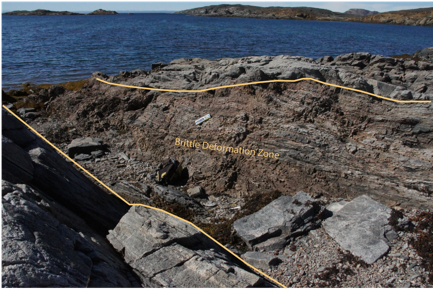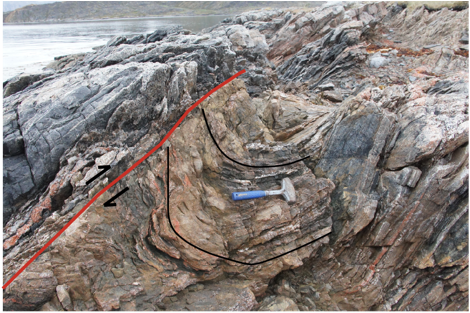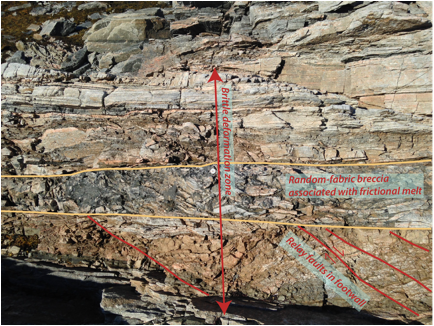Reports: UR854400-UR8: Influence of Anisotropy on Dynamic Rupture During Incipient Fault Zone Development
Joseph L. Allen, Concord University
Purpose of Study. The geometry of faults and their associated damage zones controls fault-rock properties, permeability, and fluid flow; these factors strongly influence their potential as seals or migration pathways in conventional petroleum reservoirs. They also control the strength of basement faults and their potential for reactivation, which can influence reservoir architecture. Faults accumulate displacement at variable rates spanning several orders of magnitude, encompassing a continuum between slow aseismic creep and standard earthquake slip accommodating high-velocity dynamic rupture. A significant component of the accumulated displacement and damage is gained from propagation of the latter; however, little is known of the internal geometry of high-velocity dynamic ruptures within fault zones or what geometric conditions favor their development. The goal of this project is to document the internal structure, kinematics, and dynamics of fault-zone segments that hosted high-velocity dynamic ruptures. We focus on a unique record of rupture recorded by pseudotachylyte (solidified frictional melt) preserved in a fault zone in western Greenland. The ruptures are preferentially developed in 0.5–4-m-thick brittle deformation zones localized in foliated, high-grade metamorphic rocks (Figs. 1, 2). The host rocks are characteristically layered into 1–10-m-thick bands that emulate the geometry of sedimentary beds. Since pseudotachylyte is the only clear record of high-velocity rupture that is mappable at the fault-system scale, this field site serves as a unique analog for study of rupture propagation in sedimentary strata.
Year 3 Goals and Accomplishments. In July and August, 2017 (project year 3), two undergraduates and the PI engaged in a second year of field work at the fault zone. Our field work had four goals: (1) To further refine the kinematic model we have developed; (2) to unravel the regional extent of the fault zone at the multi-kilometer scale; (3) to map and sample a 10-m-scale example of a fault zone with evidence for both compressional and dilatational deformation; and (4) to further characterize the internal geometry of an individual fault zone at the scale of 1 square km.
Our fieldwork led to some significant findings. We substantially reinforced our kinematic model and documented numerous clear cases of dextral oblique slip on a series of reverse faults linked by 1-5-m-scale lateral ramps with strike-slip displacement (Fig. 3). Field data show that compressional reverse oblique slip is counter-intuitively associated with brittle extension along 1-15-m-long segments of the footwall of individual faults. Compression within irregularly layered, anisotropic host rocks led to development of dextral strike-slip relay zones that opened the fault surface and permitted locally thick (up to 130 cm) layers of frictional melt and angular breccia to accumulate within the primary slip zone (Fig. 4).
Our work also shows that the fault system is regionally extensive. We were able to trace the system for more than 30 km and documented numerous additional discrete fault zones. On a broader scale, we engaged in reconnaissance mapping along the Precambrian orogenic front and were able to recognize frictional melts with identical kinematics at a location 120 km E-NE (077 degrees) from the easternmost exposures of the study area. This suggests that the entire fault zone may be a previously unrecognized tectonic feature spanning a length of at least 150 km.
This work has implications for petroleum reservoir heterogeneity as it shows that faults can dilatationally widen and generate random-fabric breccias during discrete high-strain-rate events such as earthquake rupture. These breccias are not observed in sections of fault zones that are not affiliated with frictional melts indicating that they only form during earthquake rupture. This suggests that the internal geometry and the mechanical secondary porosity of fault zones can be controlled by strain-rate fluctuations.
Two Concord University undergraduate students worked on the project during year 1 and 2 and participated in fieldwork during summer 2015. Both matriculated to graduate programs in geophysics and structural geology at Wright State University and the University of Vermont. They overlapped and mentored a second cohort of two undergraduate researchers during the second year of the project. The second cohort completed fieldwork in summer 2017. Both are still enrolled as undergraduate geoscience majors at Concord University.
Figure 1. Field example of a brittle deformation zone (BDZ) developed over a prolonged period of incremental slip. Zones show irregular margins and evidence for fluid flow such as replacement of albite by calcite. Episodes of earthquake rupture generate frictional melts that overprint BDZ's and create localized bands of 0.1-1 m fault breccia, which locally increases fault heterogeneity within the BDZ.
Figure 2. Cross section of one of the three major fault zones mapped in 2015.
Figure 3. Footwall fold (location of hammer) accommodating top-to-SE reverse displacement on a brittle rupture preserved as frictional melt (red line).
Figure 4. Random-fabric breccia generated during high-velocity slip and frictional melting on a dextral-oblique reverse fault within a BDZ (view down dip, coin in photo center for scale). Fault extension and dilatation during slip accommodated by dextral relay faults in footwall. High-velocity slip during earthquake rupture generates a distinct heterogeneity within the BDZ.















